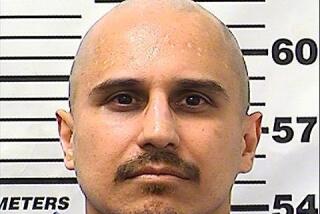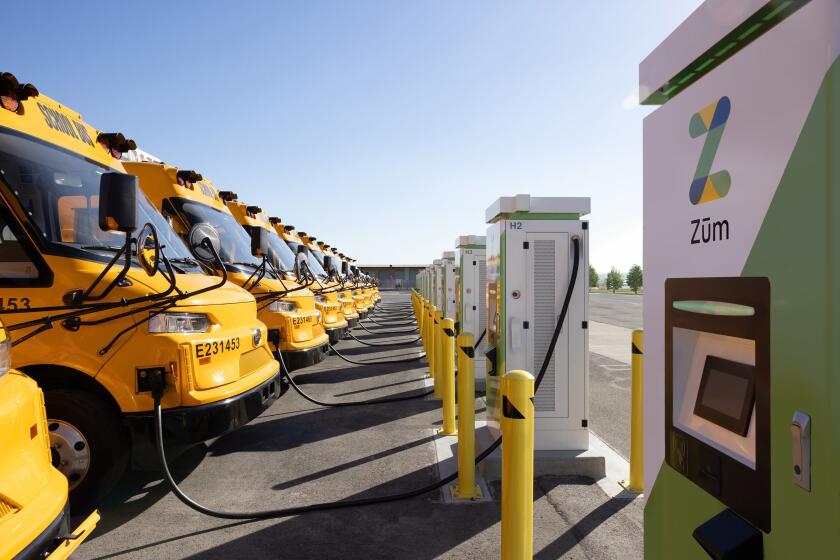COLUMN ONE : On-the-Job Schools: A for Access : Working parents praise classrooms set up at company sites or downtown malls. Children miss their neighborhood friends but enjoy chance to have Mom or Dad nearby.
Last year, Susan Bridgford faced a dilemma that has become all too common for parents yearning to get involved in their children’s education.
At the neighborhood school where her daughter, Clare, had started kindergarten, Bridgford served on an advisory council in the evenings, and she was one of the PTA stalwarts.
But with her own printing business to run during the day, she was not seeing much of Clare. She said she soon started wondering: “What’s the point?”
That’s why in August she jumped at the chance to enroll Clare in the inaugural class of the Downtown School, housed in a former bank finance office in the heart of the business district.
The Des Moines experiment is the newest of the nation’s worker-friendly schools. In Miami; Minneapolis; St. Paul, Minn.; Orlando, Fla.; Tampa, Fla., and Santa Rosa, Calif., an emerging movement aims to adapt public education to the realities of the ‘90s.
It has been a generation since most American households had two parents with only one holding an outside job. In those days, stay-at-home moms could easily represent the family at the local grade school: volunteering in classrooms, baking cookies for fund-raisers, meeting with teachers.
Now, as politicians, law enforcement officials and academics clamor for more parent involvement, at least 15 new public schools over the last five years aim to improve access to children and teachers for single parents or working couples.
Locations, school hours and meeting times are decided with job schedules in mind. The schools move beyond providing extended child care or extracurricular activities and work to expand the parent’s role as an important partner in the education process.
There are drawbacks, notably the expense. The projects are costly because they generally involve building a school or remodeling space far from residential areas. In most cases, the schools exist only because companies are willing to contribute, and they suffer the drawbacks of any school not located in the neighborhood it serves.
But they help appease a hunger among parents, teachers and children for more contact than they can get at a traditional school.
This year, Bridgford chats with Clare as they drive between school and their home in the city’s West Side. She often walks the one block from work for a casual hello. She can eat with Clare at school or take the first-grader to eat or shop during all or part of the 90-minute lunch break--when she can also schedule formal teacher conferences. The meetings of the advisory council and the PTA are held at noon.
The differences between a work day and a school day, and a work calendar and an academic calendar, are also addressed. The Downtown School has 19 more instructional days than its neighborhood counterparts. The teachers just requested an extra 15 minutes in the school day. There is a formal link with a YMCA day-care program.
But the emphasis is on including parents, rather than merely keeping children occupied while they’re away. The school asked the designer of its math curriculum to give the same talk to parents twice, at lunch and at 5 p.m. (The child-care program lasts until 6 p.m.)
By popular demand, the students will perform their upcoming holiday concert at 2:30 p.m. and again at 7 p.m. “Sometimes, one parent doesn’t work downtown, and we don’t want to exclude them,” said Jan Drees, school director.
Reaction from many quarters is enthusiastic. “Was it necessary 40 years ago? No. But it is now,” said Undersecretary of Education Marshall S. Smith. “This kind of approach enhances two critical points: the time you spend with your child and a line of communication with the teacher.”
“This is exactly the kind of thing we need to do,” said Amitai Etzioni, a George Washington University professor who has received widespread attention for his calls for a renewed spirit of community responsibility. The cornerstone of his philosophy calls for parents to pay closer attention to their children.
Others have their doubts. In Los Angeles, some flexible scheduling may result as more decision-making power moves to the local school level, said Francis Nakano, special assistant to District Supt. Sid Thompson. But given the school system’s budget crunch and the recession--all but eliminating private-sector money as a source of financing--new schools located near workplaces are not expected soon, he said.
Besides, he added, the diffuse, sprawling nature of the city would probably make such attempts impractical.
“Just because parents come onto the campus doesn’t necessarily mean there’s parental involvement,” he said. “I work, but I made an effort to communicate with my children’s teachers by phone, mail correspondence, whatever it took. And that is part of the teacher’s responsibility too.”
Still, Smith said he believes that worker-friendly schools are “definitely worth exploring. We need a mix of different types of schools.”
The Des Moines school opened three years after the Greater Des Moines Chamber of Commerce Federation told educators that local schools needed to improve. School officials responded that employers were trapping parents at work, keeping them from playing a role in education.
Both sides decided a joint venture was in order. So they pledged a three-year commitment. Nineteen businesses, from a large financial company to a small accounting firm, donated money and materials for space and furnishings downtown. The Board of Education supplied the three teachers, a part-time principal and a curriculum.
When it came to assembling a student body, it was come one-come all, first-come, first-served. The resulting 43 students, ages 5 to 7, mirror the socioeconomics of the city school system as a whole: 35% low-income, 29% minority and 13 who live with single parents. There are no grades; the children learn at their own pace.
Every day, parents take their children on an elevator to the Skywalk, a covered pedestrian mall connecting the upper levels of many downtown buildings. Next to a restaurant and across from a grocery store is an inconspicuous locked door with a Downtown School sign. A strategically placed window allows a receptionist to screen who will be buzzed in.
On an average day, 11 parents sign the guest register and head into a large, airy classroom, where the students move informally from workstation to workstation--reading, counting, writing or lounging on the carpet. Secluded alcoves are reserved for group lessons.
One father comes in regularly to replace the receptionist during her break. Another brought students on a tour of a nearby gym he manages.
Most come to spend time with their children. At a recent mid-morning tete-a-tete, Clare Bridgford carried her loose-leaf notebook carefully into a conference room so that she and her mother could sit and page through it together.
“Oh, you mixed different colors together,” Bridgford said approvingly from her chair while Clare propped herself against her mother’s left arm. Then Clare explained something else she’d just learned: Given some heat and time, ice blocks melt into water, and that same water on a burner boils.
“You hear more about what they’re doing if you hear about it during the day,” Bridgford said. “By the time she gets home, she forgets.”
Later, after her mother’s departure, Clare toyed with a green crayon and mused: “I like this. It gives us more time to play (together). We can have lunch with our parents and talk with our parents.”
Her classmates have similar sentiments. “My brother goes to a school near my house, and I wanted to go there,” said Cory Sharp, 5. “But now I don’t, and he wants to come here too.” He said he especially likes riding the bus with his mother to and from suburban Pleasant Hill.
The teachers are also happy, stressing their ongoing exchanges with students’ families. In Dawn Vetter’s 14 years at other Des Moines schools, “50% parental involvement was considered good,” she said. “Here, it’s 100%. It’s not that parents don’t try and teachers don’t try. It’s just that time becomes such an issue.”
Even short conversations at drop-off and pickup time each day provide Vetter with openings to make casual suggestions that might not be worth a formal conference. She was sure one family didn’t spend much leisure time with books, so she handed the parent a book the child enjoyed in class. Take it home, she urged, and read it together. Parents feel more free, she added, to let her know if there are problems or changes at home.
“It makes me more effective as a teacher,” she said.
Such scenarios are repeated in workplaces as varied as the Miami International Airport, where children of pilots, postal workers and ticket clerks have learned together since 1988, and Hewlett-Packard in Santa Rosa, where the parents of 75 students work at the electronics company as well as nearby hospitals and stores.
“It’s just phenomenal the number of parents you see in the classroom, working with their child and with other people’s children,” said Steve Nielsen, principal of Hidden Valley Elementary School in Santa Rosa. He also administers the school at Hewlett-Packard, christened the Hidden Valley Satellite when it opened last February as a sort of sister campus.
The first modern workplace school started in 1987 as a solution to overcrowding in Dade County, Fla. The district could not afford to construct more buildings, so the superintendent asked the American Bankers Insurance Group if the company would host students at its international headquarters in Miami, if teachers and learning materials were provided.
The answer was yes. Soon it became apparent American Bankers employees with students in the school were able to spend more time than ever with their children and the teachers.
In a 1991 report, the district released results of a survey of parents of the 72 students attending kindergarten, first and second grades at the American Bankers school. The responses were overwhelming: 96% said they were more likely to volunteer in school activities as a result of their enrollment near work; 98% were more likely to visit their children during the school day; 100% said they had more opportunities to communicate with their children during the workweek; 96% said their days were less complicated.
All of the parents said they believed that their children were getting as good or better an education at the workplace school than they would at a neighborhood school. Test scores backed them up.
At the same time, 98% said they were better able to work knowing their children were close by; 92% said the arrangement helped them arrive at work on time; 84% said they were less likely to be absent. Supervisors and personnel records confirmed these assessments.
These advantages, the parents said, far outweighed the negatives.
They did worry, however, about the small size of the workplace school. They wondered if their children would learn to socialize well in settings where they receive less attention or have to make friends with many strangers.
They wish the school would serve older children--few of the projects enroll pupils past age 8--although they acknowledge that by middle school and high school, parental visits would be a source of more embarrassment than pleasure on the student’s part.
In Des Moines, parents voice similar concerns. They also note that the Downtown School is a victim of its location. They admit to some anxiety about crime. There is no outdoor play space, though children can use the YMCA gym and swimming pool after class.
The quarters are so cramped that the staff lives without a restroom; rather than share facilities with the students, the principal goes to the Convention Center half a block away, and teachers walk to a nearby hotel.
With classmates from all over the city, “it’s hard to have neighborhood friends, and the school friends aren’t someone you can just call a buddy,” Bridgford added. “I’d like to do a student directory so they can get together on weekends.”
On the other hand, the children take daily field trips--to City Hall, to the shoeshine stand, to museums. They can walk to all of them.
At the Hawkeye Pantry market, they asked the manager how the food gets to the store and if Michael Jackson had ever shopped there. One bemused customer, a retired salesman named Andy Anderson, watched from a table near the back, smoking a cigarette and sipping coffee from a foam cup.
He knew who the youngsters were; they have become a familiar sight in this once all-adult environment. “In this day and age, contact with children is so important for working mothers and fathers,” Anderson said. “Maybe this is part of the way to fix what’s wrong with America.”
The school had two open slots this year, but 35 newcomers have signed up for next fall and most of the current students are expected to return. “We’re planning to add one teacher and we’ll still need to have a lottery,” said Don Brubaker, the school district’s executive director of early childhood and elementary education.
From Brubaker’s standpoint, the school is already a success. Children who might well have gone to suburban, parochial or private schools have stayed with the city system. The parents are everywhere. With private contributions of $500,000 for the next three years, the district hasn’t laid out any extra money.
While fielding inquiries from as far as Kansas and New York, he and school director Drees are beginning to think about where the next worker-friendly school might be set up in Des Moines: an industrial park perhaps, or a shopping area, or even another one downtown. After all, the central city fills with 60,000 employees every day. There are a lot more commuter parents to accommodate out there.
More to Read
Start your day right
Sign up for Essential California for news, features and recommendations from the L.A. Times and beyond in your inbox six days a week.
You may occasionally receive promotional content from the Los Angeles Times.






